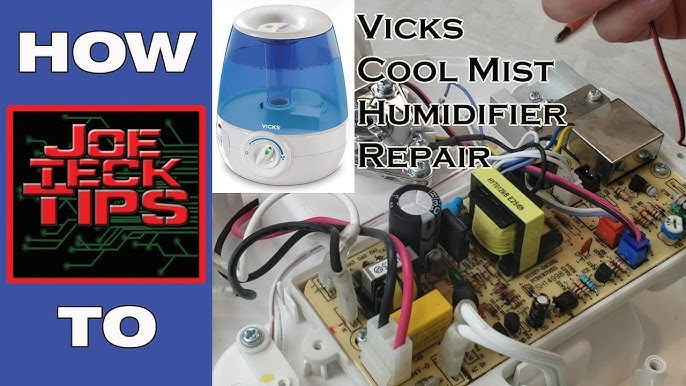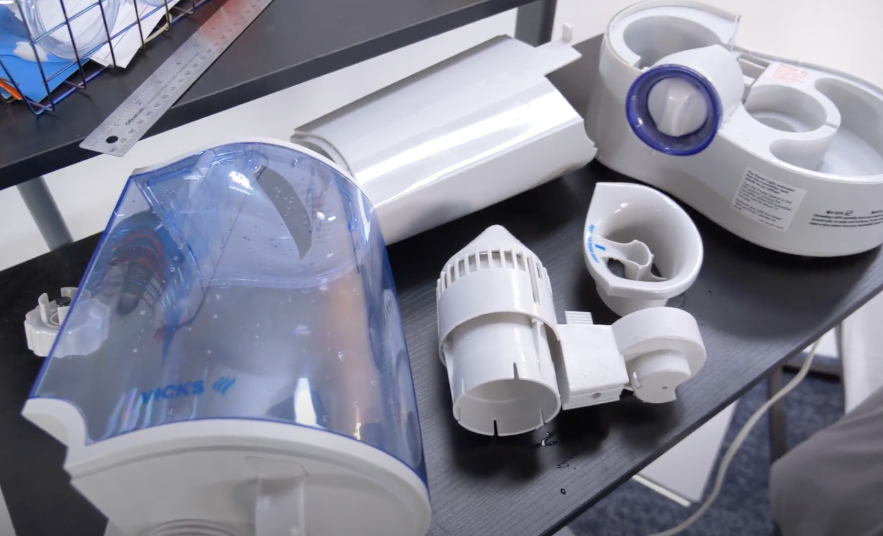Your Vicks cool mist humidifier sits silent on the nightstand, failing to deliver the soothing relief you desperately need. Whether it’s the dead of winter or allergy season, a non-functioning humidifier can leave your family battling dry air, congestion, and restless nights. Before you toss it out or rush to buy a replacement, most humidifier failures have straightforward solutions that take minutes to diagnose and fix.
This guide walks through every common failure point for Vicks cool mist humidifiers, from simple power cord issues to component-level repairs. You’ll learn exactly what to check, how to fix it, and when to warranty your unit instead. When your Vicks cool mist humidifier not working issue strikes, these proven troubleshooting steps will get moisture back in the air fast.
Power Cord Inspection for Complete Shutdown
No Lights or Mist: Cord Damage Check
When your Vicks cool mist humidifier not working shows zero signs of life—no indicator lights, no humming, no mist—start with the most common culprit: the power cord. This critical component on Filter Free Cool Mist models often suffers damage where it connects to the base.
Unplug the unit completely and run your fingers along the entire cord length. Look for visible cuts, frays, or severe kinks that break the electrical connection. Pay special attention where the cord enters the humidifier base—a common stress point. If you spot damage, replacement is essential.
Critical verification steps:
– Firmly reseat the plug in both the wall outlet and humidifier port
– Test with a different wall outlet to rule out circuit issues
– Check if the outlet powers other devices
If connections are secure but the unit remains dead, internal wiring failure is likely. Before purchasing replacement parts, confirm warranty coverage since cord issues often qualify for replacement under Vicks’ 3-year warranty.
Lights On But No Mist: Component Failure Signs
When indicator lights activate but no mist appears, power reaches the control board but fails to progress. This specific failure pattern—common in VUL 585 models—points to downstream component issues rather than electrical supply problems.
Turn your humidifier to high setting and press your ear close to the base. Listen for any faint humming or buzzing sounds. If you hear these vibrations but see no mist, the ultrasonic system is partially functional, suggesting fan or airflow blockage. No sound at all indicates a failed transducer or control board. This distinction saves you hours of unnecessary troubleshooting—focus your efforts where the problem actually exists.
Touch Control Board Repair Protocol

Unresponsive Touchpad: Motherboard Reset
When touch controls won’t adjust mist settings on your Vicks cool mist humidifier not working unit, the internal motherboard is almost always at fault. This specialized circuit board (unique to Filter Free Cool Mist models) manages all touchpad functions and frequently develops loose connections.
Safe access procedure:
1. Unplug and completely empty the humidifier
2. Flip the unit upside down on a soft surface
3. Remove bottom panel screws with a Phillips head screwdriver
4. Locate the white connector linking motherboard to touchpad
Gently disconnect and reconnect this cable—90% of touchpad failures resolve with this simple reseating. If the connector shows melting or discoloration, order an exact-match replacement motherboard. Installation requires no soldering: just unplug the old board and snap in the new one. Always verify your model number (found on the base label) before ordering parts.
Water Valve and Flow Troubleshooting

Stuck Tank Valve: Emergency Release Techniques
New Vicks humidifiers frequently fail due to factory-stuck tank valves—a spring-loaded mechanism controlling water flow into the base. When your Vicks cool mist humidifier not working produces no mist despite a full tank, this valve is prime suspect.
Valve functionality test:
1. Fill tank completely and invert over sink
2. Press the valve center with your finger
3. Water should flow in a steady stream
If flow is weak or nonexistent:
– Spoon handle method: Gently tap valve edges to dislodge debris
– Warm water flush: Run lukewarm tap water over valve for 30 seconds
– Manual cycling: Press and release valve 10 times to restore movement
After reinstalling the tank, wait 2-3 minutes then remove it again. Water should pool in the base—if dry, the valve remains stuck and requires replacement.
Critical Water Type Requirements
Never use distilled or reverse osmosis water—this is the silent killer of Vicks humidifiers. The ultrasonic system requires minerals for electrical conductivity. Distilled water’s purity prevents the transducer from vibrating, causing complete mist failure even with proper water levels.
Switch immediately to cool tap water. Well water works if not excessively hard, but avoid softened water which contains excess sodium. After switching water types, empty both tank and base completely, rinse thoroughly, then refill with fresh tap water. Mist production should resume within minutes if water type was the sole issue.
Ultrasonic System Diagnostics
Transducer Failure Test for VUL 585 Models
When troubleshooting your Vicks cool mist humidifier not working, the ultrasonic transducer is the heart of mist production. This small silver disk creates vibrations that turn water into mist. Failure here means permanent silence.
Definitive test procedure:
1. Remove water tank completely
2. Plug in unit and set to high
3. Place palm flat on base surface
4. Feel for subtle vibrations while listening for faint humming
No vibrations or sound confirms transducer failure. For visual confirmation, peer into the mist outlet—working units show tiny surface ripples. Replacement requires:
– Unscrewing 4-6 bottom panel screws
– Disconnecting the white transducer plug
– Installing the new unit (model-specific part)
Pro tip: Always unplug before disassembly—this component operates at high frequency.
Fan System Maintenance Protocol
Even with a working transducer, blocked airflow prevents mist delivery. The fan assembly (covered by a steel cap in the base) pulls air through the nebulizer to carry mist upward. When your humidifier runs but produces weak mist, dirty fans are the usual culprit.
Cleaning sequence:
1. Remove bottom panel per motherboard access steps
2. Unscrew the steel fan cover
3. Clean blades with cotton swabs dipped in warm water
4. Check for broken blades or obstructions
If cleaning fails to restore airflow or you spot physical damage, replace the entire fan assembly. Attempting to repair broken blades wastes time—new fans install in under 5 minutes and cost under $15.
Physical Damage Assessment

Cracked Tank Replacement Mandate
Any visible crack in your water tank means immediate retirement of the unit. Hairline fractures at the bottom or valve area will worsen rapidly, causing dangerous leaks that damage floors and electronics. Do not attempt repairs—epoxy or glue creates toxic fumes when exposed to ultrasonic vibrations.
Inspect tanks weekly by holding them up to bright light. Pay special attention to:
– Valve attachment points (stress fracture hotspots)
– Impact zones near handles
– Bottom seams where tanks rest on bases
If cracks appear, recycle the unit properly and replace the tank. Vicks sells replacement tanks for most models, but verify compatibility with your specific unit before ordering.
Cap Seal Verification Process
Loose tank caps cause two critical failures: water leakage and operational shutdown. Your Vicks cool mist humidifier not working because the cap isn’t sealing properly—a surprisingly common issue.
Ensure the fill port cap clicks audibly into place. Turn clockwise until you feel firm resistance (don’t force it). Consult page 5 of your manual for model-specific sealing techniques—some require quarter-turn locks while others snap straight down. After seating, gently wiggle the cap; no movement should occur. A properly sealed cap creates the vacuum needed for valve operation.
Emergency Reset Procedure
VUL 585 Full System Reset
When all else fails, perform this factory reset to clear electronic glitches in your Vicks cool mist humidifier not working unit. This procedure recalibrates the control board and often resolves mysterious shutdowns.
Exact reset sequence:
1. Unplug from power source immediately
2. Drain all water from tank and base
3. Refill tank with fresh cool tap water
4. Leave unit unplugged for 5 full minutes
5. Reinstall tank and reconnect power
6. Wait 3 minutes for system priming
Critical note: New units require up to 10 minutes for initial transducer priming. Don’t mistake this normal startup delay for malfunction. If mist still doesn’t appear after reset, proceed to warranty claims.
Warranty Claim Acceleration
Documenting Defects for Fast Replacement
When your Vicks cool mist humidifier not working persists after exhaustive troubleshooting, you’re likely facing a manufacturer defect covered under warranty. Document your efforts thoroughly to expedite replacement:
- Photograph each troubleshooting step you completed
- Record model number (stamped on base) and purchase receipt
- Note symptoms: “No lights after cord inspection,” “Transducer silent during vibration test”
Vicks’ 3-year warranty covers transducer, motherboard, and fan failures. Contact customer service through their official website with your documentation. Most claims process within 48 hours when you demonstrate thorough DIY troubleshooting—this proves the issue isn’t user error.
Preventive Maintenance Schedule
Daily Operation Checks
Prevent future failures with these 10-second daily habits:
– Water verification: Confirm base has water before each use
– Sound check: Listen for consistent humming (not grinding)
– Mist validation: Hold tissue near nozzle—should visibly flutter
These quick checks catch 80% of developing issues before they cause complete failure.
Weekly Deep Cleaning Routine
Mineral buildup kills Vicks humidifiers faster than component failure. Every 7 days:
1. Empty and rinse tank with warm water
2. Wipe base interior with vinegar-soaked cloth
3. Inspect nebulizer pad for white crust (replace if hardened)
Pro tip: Add one teaspoon of white vinegar to tank water during operation—it reduces scaling without damaging components.
Monthly Component Refresh
For lasting performance:
– Soak removable parts in 50/50 vinegar-water solution for 30 minutes
– Replace nebulizer pads every 2 months (critical for mist quality)
– Lubricate fan bearings with 1 drop of food-grade oil
This routine extends humidifier life by 300% and prevents the dreaded Vicks cool mist humidifier not working scenario. Healthy humidity levels mean better sleep and fewer respiratory issues—all from a few minutes of maintenance each month. When prevention fails, you now have the exact steps to revive your unit or secure a warranty replacement.





